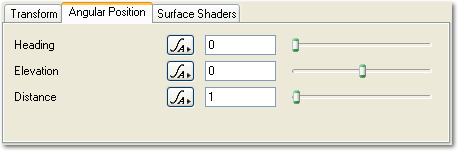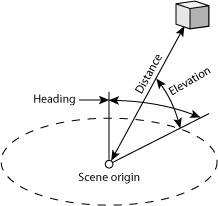LWO Reader - Angular Position Tab
Description:
This tab has settings which use angles and distance to set the position of the object relative to the scene origin. These settings are an alternative to using the Translate setting in the Transform tab. The diagram below shows how all the parameters relate to each other and the origin.
Settings:
- Heading: This angle sets the rotation of the object around the scene origin, in the XY plane, increasing as you turn clockwise.
-
Elevation: This angle sets the vertical part of the position. You could think of it as the angle above or below the horizon. 90 is straight up, -90 is straight down.
-
Distance: This sets the distance from the origin, in metres.
Back to: LWO Reader

